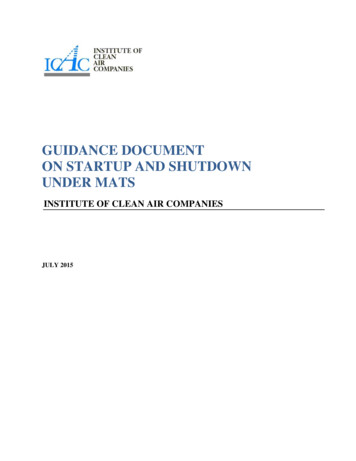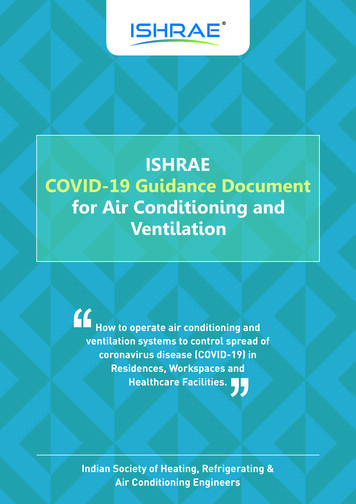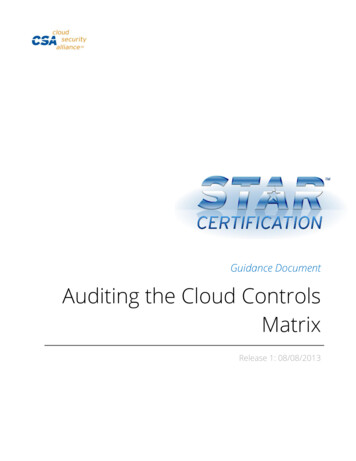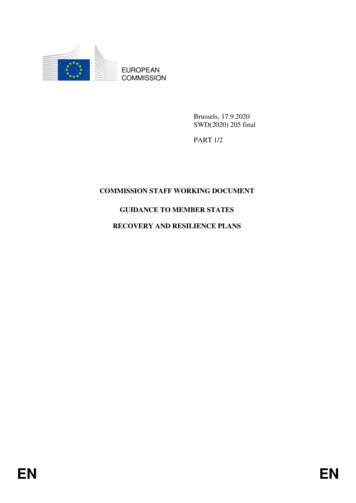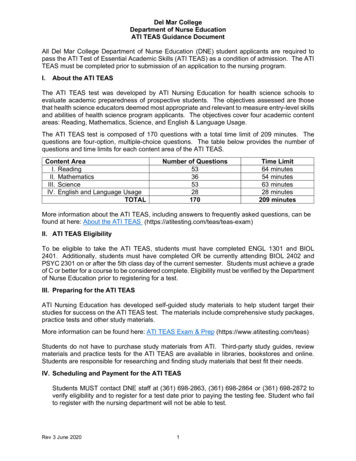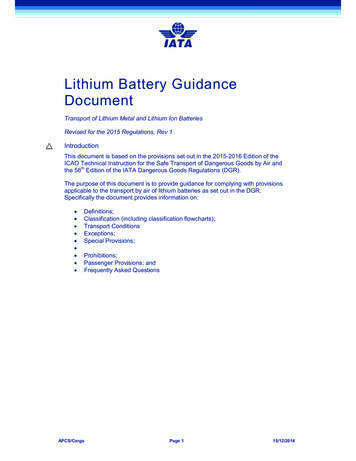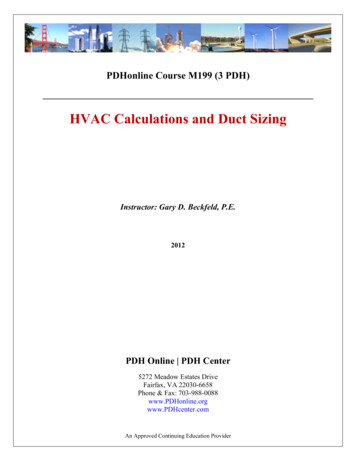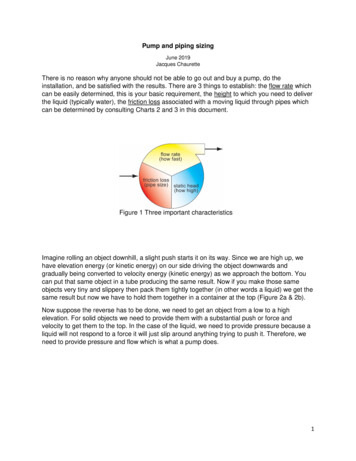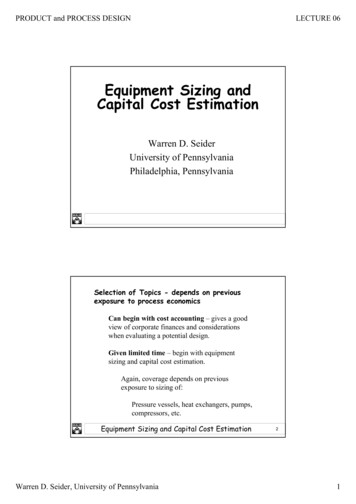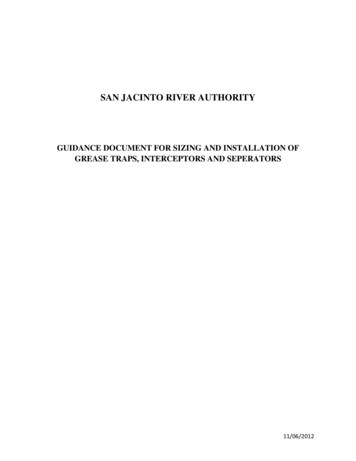
Transcription
SAN JACINTO RIVER AUTHORITYGUIDANCE DOCUMENT FOR SIZING AND INSTALLATION OFGREASE TRAPS, INTERCEPTORS AND SEPERATORS11/06/2012
Part I: Guidance for Grease Trap/Grease Interceptor Sizing and Design CriteriaA. Introduction:Information contained within this document is based on standard industry practices andguidance found in the Uniform Plumbing Code (UPC) and the City of Houston PlumbingCode. Size, type, and location of grease traps/grease interceptors shall be in accordance withthe manufacturer’s instructions, the requirements of San Jacinto River Authority (SJRA) andthe City of Houston Plumbing Code.B. Applicability:These requirements are applicable to all commercial food service establishments, includingthose that are undergoing:1.2.3.4.New ConstructionInterior remodeling to accommodate expansion or operational modificationsChanges of ownership/occupancyFacilities which may be experiencing difficulty in achieving compliance withmaintenance and/or wastewater discharge limitations.Waste discharge in establishments from fixtures and equipment which contain grease,including but not limited to, scullery sinks, pot and pan sinks, dishwashers, soup kettles, andfloor drains located in areas where grease-containing materials exist, shall be permitted to bedrained into the sanitary waste through the grease trap/grease interceptor when approved bySJRA.C. Sizing Requirements:Sizing methods described herein are intended as guidance in determining grease trap/greaseinterceptor sizes that will afford the POTW’s sanitary sewer system a minimum degree ofprotection against grease and other obstructing materials. Sizing determinations are based onoperational data provided by business owners or their contractors. In approving a customer’splumbing or grease trap design, the SJRA does not accept liability for the failure of a systemto adequately treat wastewater to achieve effluent quality requirements specified under SJRAGrease Order. It is the responsibility of the generator and/or contractors to ensure theappropriate level of treatment necessary for compliance with federal, state and localregulations.D. Grease Trap/Grease Interceptor Sizing Formulas:It is the responsibility of the generator and his/her contractors to ensure that the wastewaterdischarged from the facility is in compliance with the SJRA’s discharge limitations. For the11/06/2012
purpose of plans review, a general assessment of grease trap/grease interceptor design andsize will be performed using the following formulas. (These formulas have beendemonstrated as industry standards capable of achieving the SJRA’s discharge criteria whensystems are maintained in proper condition.)Hydro-mechanical Grease Trap:The Hydro-mechanical Grease trap design type incorporates air entrapment, the buoyancy ofgrease in water and hydro mechanical separation with interior baffling for grease, FOG (fats,oils and grease) separation. Hydro-mechanical Grease traps continuously separate the FOG atthe velocity it enters the interceptor.The size of Hydro-mechanical Grease traps is expressed in the gallons per minute flow(GPM) that the grease trap can accept and still remove the grease and FOG from the influent.On the other hand, the size of a Gravity Grease Interceptor is based on the actual volume ofwater the interceptor will hold expressed in gallons.Hydro-mechanical Grease Trap Sizing By Pipe Size, Using Gravity FlowRate (Using Uniform Plumbing Code)Where fixture dimensions and flow rates are unknown, sizing may be achieved by calculatingflow through primary drainage line using following Table (Table 10-2 of Uniform PlumbingCode):Diameter ofGrease Waste Pipe2”3”4”5”6”Uniform Plumbing Code Table 10-2Maximum Full PipeSize of Grease TrapFlow (gpm) 11-Minute Drainage2-Minute DrainagePeriod (gpm)Period (gpm)202010607535125150752302501253755002501. ¼” (6.35 mm) slope per foot based on Manning’s formula with friction factorN 0.012.11/06/2012
Hydro-mechanical Grease Trap Sizing By Flow Rate, Using FixtureCapacity (Using Uniform Plumbing Code)Where fixture dimensions and/or fixture load/hydrant capacity (gallons) of all connectedfixtures and equipment are known, grease traps may be sized as follows (GPM):[(𝑳" 𝑾" 𝑯") 𝟐𝟑𝟏] 𝟎.𝟕𝟓𝑫.𝑷.(𝟏 𝒐𝒓 𝟐 𝒎𝒊𝒏.) GPM, if fixture dimensions are knownWhere, Drainage volume ([(𝑳" 𝑾" 𝑯") 𝟐𝟑𝟏] 𝟎. 𝟕𝟓) GallonsOr𝑹𝒂𝒕𝒆𝒅 𝑭𝒊𝒙𝒕𝒖𝒓𝒆 𝑳𝒐𝒂𝒅 (𝒈𝒂𝒍𝒍𝒐𝒏𝒔)𝑫.𝑷.(𝟏 𝒐𝒓 𝟐 𝒎𝒊𝒏.) GPM, if fixture load/hydrant capacity (gallons) is knownfor rated appliances such as dishwasher, water wash hood at manufactures ratings.Where L” Length of the fixture unit in inch, W” Width of the unit in inch,H” Depth/height of the unit in inch and D.P. Drainage Period in minute1. Calculate the volume of each connected fixture. 1 gallon 231 cubic inch.2. Multiply the volume of connected fixture by a fill factor of 0.75 to obtain the drainagevolume (gallons).3. Add known load/hydrant capacity (gallons) of all connected appliances, hydrants andequipment to the calculated drainage volume in step 2.4. Divide the total discharge volume by a drain period of one minute or two minutes forslower drain time.5. The minimum grease trap size (gpm) is the total calculated flow rate (step 4) dischargingto the t size224’X24”X12”Rated Appliance(Hydrant)Rated ApplianceAdding all units, Total2.Load(gallons)44.9Size of Grease Trap (GPM) 21 Min. D.P.2 Min. D.P.3249.95025Rounded up to the next nominal size.11/06/2012
Gravity Grease Trap/Grease Interceptor:Gravity grease interceptors shall be designed to remove grease from effluent and shall besized in accordance with this section. Gravity grease interceptors shall also be designed toretain grease until accumulations can be removed by pumping the interceptor.Gravity Grease Interceptor Sizing By Pipe Size (Using City of HoustonPlumbing Code)Diameter ofGrease WastePipe 32”3”4”5”6”Full Pipe Flow (nominal) 419.44 gpm58.67 gpm125.77 gpm229.75 gpm375.47 gpmInterceptor size based on 30 minuteretention time, Rounded up to nextnominal size 5750 gallons2000 gallons4000 gallons7500 gallons15000 gallons3.For interceptor sizing by fixture capacity see the example below.4 . (0.240) slope per foot based on Manning formula with friction factor N 0.012;Cast Iron Soil Pipe and Fittings Handbook; Ch. 8, Flow Theory and Capacity; pp:130-134 (Full Pipe); Cast Iron Soil Pipe Institute (CISPI); 5959 Shallow ford Road,Suite 419, Chattanooga, TN 37421.rd5 . Based on 30 minute retention time (ref.) Metcalf & Eddy, Inc. 3 Ed. Small andDecentralized Wastewater Management System (1998) and rounded up to nominalinterceptor volume.Gravity Grease Interceptor Sizing Using Fixture Capacity (Using City ofHouston Plumbing Code)Where fixture dimensions and/or fixture load/hydrant capacity (gallons) of all connectedfixtures and equipment are known, interceptors may be sized as follows:Step 1:Fixture Capacity ([(𝑳" 𝑾" 𝑯") 𝟐𝟑𝟏] 𝟎. 𝟕𝟓) GallonsStep 2:Add hydrant capacity (gpm supply): Add rated appliances such as dishwasher, water washhood at manufactures ratings.11/06/2012
Step 3:Minimum Interceptor sizing (gallons) Total Fixture Capacity 30Example:FixturesCompartmentsCompartment size224’X24”X12”Rated ApplianceAdding all units, Total6.Load(gallons)44.9246.9Recommended Interceptor SizeBased on 30 min retention time 61500 gallonsRounded up to the next nominal size.E. Alternate Sizing Formulas / ProposalsFood service establishments that propose the use of alternate sizing techniques and/orprocedures that result in specifications that differ from calculated requirements, must submitformulas and other bases to support proposed grease trap/grease interceptor size/installation.Submission should also provide documentation of ability to meet effluent qualityrequirements. This proposal must be signed by a licensed plumbing contractor orprofessional engineer.F. Construction / InstallationEach grease trap/grease interceptor shall be so installed and connected that it shall be at alltimes easily accessible for inspection, cleaning, and removal of the intercepted grease. Allpermitting, construction, design and inspection activities must be completed in accordancewith the manufacturer’s instructions, the City of Houston Plumbing Code, the requirementsof SJRA or other approved plumbing codes. Additionally, the following specifications mustbe incorporated into grease trap design.1. The grease trap/grease interceptor shall be constructed with a minimum of twobaffles.2. Grease traps/grease interceptors are to be installed at a minimum distance of 10 ft.from sinks and dishwashers to allow for adequate cooling of the wastewater. Watertemperatures must be less than 120 degrees prior to entering grease trap.3. All grease bearing waste streams should be routed through an appropriate greasetraps/grease interceptor, including: three-compartment sinks, pot/pan sinks, soupkettles, hand-washing sinks, dishwashers, mop sinks and floor drains. NotableExceptions: Drains that receive “clear waste” only, such as from ice machines,11/06/2012
condensate from coils and drink stations, may be plumbed to the sanitary systemwithout passing through the grease trap.4. All exterior or recessed grease traps/grease interceptors are to be installed with anEffluent Sampling Well.G. Customer (Generator) ResponsibilitiesIt is the responsibility of the customer (waste generator) to ensure compliance with the SJRAdischarge limitations specified in SJRA Grease Order.Hazardous wastes, such as acids, strong cleaners, pesticides, herbicides, paint, solvents, orgasoline should not be disposed of where they would go through grease traps, interceptors orseparators. If commercial dishwashers are discharged through a grease trap, care must betaken in system design. Dishwashers use detergents and elevated water temperatures that willmelt grease. If the grease trap is either too small or too close to the commercial dishwasher,grease may pass through the grease trap and into the collection system.Generators are responsible for maintaining grease traps, interceptors and separators incontinuous proper working condition. Further, generators are responsible for inspecting,repairing, replacing, or installing apparatus and equipment as necessary to ensure properoperation and function of grease traps, interceptors and separators, and compliance withdischarge limitations at all times.The generator must have grease traps, interceptors and separators serviced (pumped, cleaned,and inspected) by a TCEQ licensed and SJRA registered waste hauler, at a minimumfrequency of every 90 days or more often as necessary, to ensure proper function. Records ofservicing (waste manifest) are required to be maintained on site for five (5) years. The 90 dayservicing frequency assumes proper sizing and installation consistent with this guidance.Any person who owns or operates a grease trap, interceptor or separator may submit to SJRAa request in writing for an extension to the ninety (90) day pumping frequency. SJRA maygrant an extension for required cleaning frequency on a case-by-case basis. In any event, agrease trap, interceptor or separator shall be fully evacuated, cleaned, and inspected at leastonce every 180 days.Enzymes, solvents, and emulsifiers are not permitted as they will only change the form ofgrease, allowing it to be carried out of the grease trap with the wastewater and deposited inthe collection system.11/06/2012
H. Food Waste Disposal UnitsUnless specifically required or permitted by the Authority, no food waste disposal unit shallbe connected to or discharge into any grease interceptor. Commercial food waste disposersshall be permitted to discharge directly into the building’s drainage system.11/06/2012
Part II: Guidance for Interceptor and Separator Sizing and Design CriteriaInterceptors and separators are required for oil, grease, sand and other substances harmful orhazardous to the building drainage system, the public sewer or sewage treatment plant. Design,size, and location of pretreatment devices must be submitted by a licensed plumbing contractoror professional engineer for review and approval.A. LaundriesCommercial Laundries, Laundromats, and dry-cleaners shall be equipped with a lintinterceptor in order to reduce the quantity of lint and silt that enter the collection system. Thesystem must be of adequate size and design to allow for cool-down of wastewater so thatseparation can be more readily achieved.Laundry equipment in commercial and industrial buildings that does not have integralstrainers shall discharge into an interceptor having a wire basket or similar device that isremovable for cleaning and that will prevent passage into the drainage system of solids ½inch (12.7 mm) or larger in maximum dimension, such as string, rags, buttons or other solidmaterials detrimental to the public sewerage system.An approved lint interceptor shall be installed for all commercial laundries.Exceptions:1. A laundry containing no more than 4 automatic clothes washers2. A laundry in an R-2 Occupancy containing no more than 10 automatic clotheswashersFor other than a mechanical lint interceptor properly sized to manufacturer’s instruction, seethe Appendix: Drawings LT-1, LT-2 and LT-3 for minimum size and construction criteria.The lint interceptor should be cleaned (or pumped out) routinely to prevent the escape ofappreciable quantities of grease. Cleaning should be performed when the interceptor is at75% of lint/silt retention. The frequency of cleaning at any given installation will varydepending on use. Pumping frequencies for Laundromats usually range from once a month toevery six months.B. Minimum Requirements for Auto Wash RacksEvery private of public wash rack and/or floor or slab used for cleaning machinery ormachine parts shall be adequately protected against storm or surface water and shall drain ordischarge into an interceptor (clarifier) of an approved design for this use. See Appendix:Drawing MT-1 for minimum size and construction criteria.11/06/2012
C. Hair TrapHair discharged in amounts which will cause interference, pass through, or obstruction to theflow in the POTW is prohibited. Hair traps are required whenever SJRA deems it necessary.SJRA may require hair traps for beauty salons, barber shops, pet grooming facilities,hospitals or wherever hair clogging is a problem.At a minimum, the hair trap unit shall be designed with 1-1/2” inlet and outlet and is capableof handling the drainage volume for 1-1/2” pipe size. Trap sizes shall not be increased to thepoint where the fixture discharge may be inadequate to maintain their self-scouringproperties. City of Houston Plumbing Code shall be applicable. Cleaning should beconducted in accordance with manufacturer's instructions and before the unit becomesclogged.D. Sand/Grit Interceptors (Using Uniform Plumbing Code)Whenever the discharge of a fixture or drain contains solids or semi-solids heavier than waterthat would be harmful to a drainage system or cause a stoppage within the system, thedischarge shall be through a sand/grit interceptor. Multiple floor drains shall be permitted todischarge into one sand interceptor.Sand interceptors are required whenever POTW deems it advisable to have a sand interceptorto protect the drainage system.Sand interceptors shall be built of brick or concrete, prefabricated coated steel, or otherwatertight material. The interceptor shall have an interior baffle for full separation of theinterceptor into two (2) sections. The outlet pipe shall be the same size as the inlet pipe of thesand interceptor, the minimum being three (3) inches (80 mm), and the baffle shall have two(2) openings of the same diameter as the outlet pipe and at the same invert as the outlet pipe.These openings shall be staggered so that there cannot be a straight line flow between anyinlet pipe and the outlet pipe. The invert of the inlet pipe shall be no lower than the invert ofthe outlet pipe.The sand interceptor shall have a minimum dimension of two (2) feet square (0.19 m2) forthe net free opening of the inlet section and a minimum depth under the invert of the outletpipe of two (2) feet (610 mm).For each five (5) gallons (18.9 L) per minute flow or fraction thereof over twenty (20)gallons (75.7 L) per minute, the area of the sand interceptor inlet section is to be increased byone (1) square foot (0.09-square meter). The outlet section shall at all times have a minimumarea of fifty (50) percent of the inlet section.The outlet section shall be covered by a solid removable cover, set flush with the finishedfloor, and the inlet section shall have an open grating, set flush with the finished floor andsuitable for the traffic in the area in which it is located.11/06/2012
Sand and similar interceptors for every solid shall be so designed and located as to be readilyaccessible for cleaning, shall have a water seal of not less than six (6) inches (152 mm), andshall be vented.E. Oil and Flammable Liquid Separator (Using Uniform Plumbing Code)All repair garages and gasoline stations with grease racks or grease pits, and all factories thathave oily, flammable, or both types of wastes as a result of manufacturing, storage,maintenance, repair, or testing processes, shall be provided with an oil or flammable liquidseparator that shall be connected to all necessary floor drains. The separation or vaporcompartment shall be independently vented to the outer air. If two (2) or more separation orvapor compartments are used, each shall be vented to the outer air or shall be permitted toconnect to a header that is installed at a minimum of six (6) inches (152 mm) above the spillline of the lowest floor drain and vented independently to the outer air. The minimum size ofa flammable vapor vent shall be not less than two (2) inches (50 mm), and, when ventedthrough a side-wall, the vent shall be not less than ten (10) feet (3,048 mm) above theadjacent level at an approved location. The separator shall be vented on the sewer side andshall not connect to a flammable vapor vent. All oil and flammable separator shall beprovided with gastight cleanout covers that shall be readily accessible. The waste line shallbe not less than three (3) inches (80 mm) in diameter with a full size cleanout to grade. Whena separator is provided with an overflow, it shall be provided with an overflow line (not lessthan two (2) inches (50 mm) in diameter) to an approved waste oil tank having a minimumcapacity of five-hundred fifty (550) gallons (2,082 L) and meeting the requirements ofPOTW. The waste oil from the separator shall flow by gravity or shall be pumped to a higherelevation by an automatic pump. Pumps shall be adequately sized and accessible. Waste oiltanks shall have a two (2) inch (50 mm) minimum pump-out connection at grade and a oneand one-half (1-1/2) inch (40 mm) minimum vent to atmosphere at an approved location notless than ten (10) feet (3,048 mm) above grade.Each manufactured separator that is rated shall be stamped or labeled by the manufacturerwith an indication of its full discharge rate in gpm (L/m). The full discharge rate to such aseparator shall be determined at full flow. Each separator shall be rated equal to or greaterthan the incoming flow and shall be provided with an overflow line to an underground tank.Separators not rated by the manufacturer shall have a depth of not less than two (2) feet (610mm) below the invert of the discharge drain. The outlet opening shall have not less than aneighteen (18) inch (457 mm) water seal and shall have a minimum capacity as follows:Where not more than three (3) motor vehicles are serviced and/or stored, interceptors shallhave a minimum capacity of six (6) cubic feet (0.17 m3), and one (1) cubic foot (0.03 m3) ofcapacity shall be added for each vehicle up to ten (10) vehicles. Above ten (10) vehicles, theAuthority shall determine the size of the separator required. Where vehicles are serviced onlyand n
guidance found in the Uniform Plumbing Code (UPC) and the City of Houston Plumbing Code. Size, type, and location of grease traps/grease interceptors shall be in accordance with the manufacturer’s instructions, the requirements of San Jacinto River Authority (SJRA
